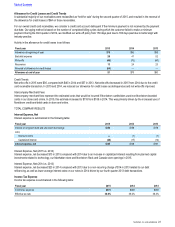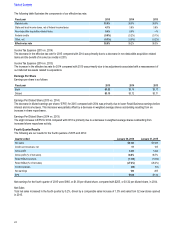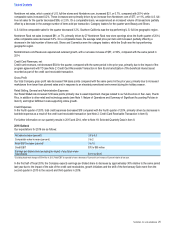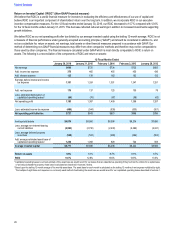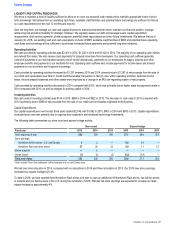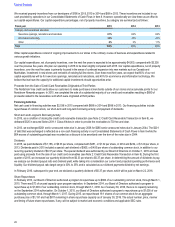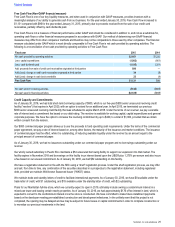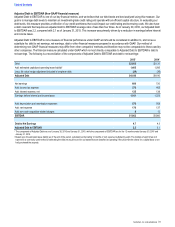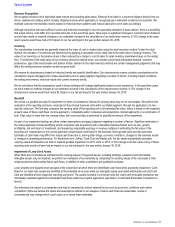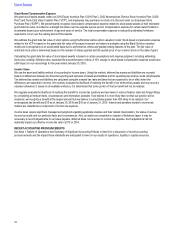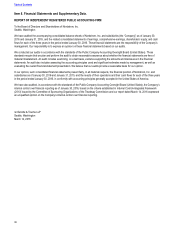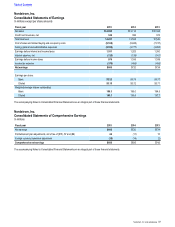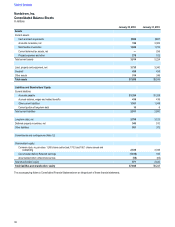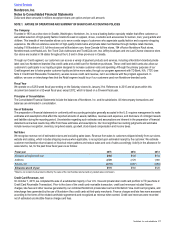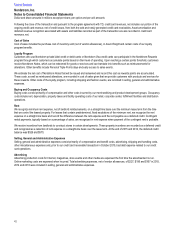Nordstrom 2015 Annual Report Download - page 32
Download and view the complete annual report
Please find page 32 of the 2015 Nordstrom annual report below. You can navigate through the pages in the report by either clicking on the pages listed below, or by using the keyword search tool below to find specific information within the annual report.
Contractual Obligations
The following table summarizes our contractual obligations and the expected effect on our liquidity and cash flows as of January•30, 2016.
We expect to fund these commitments primarily with operating cash flows generated in the normal course of business and credit available to
us under existing and potential future facilities.
Total
Less€than
1 year 1 – 3€years 3 – 5€years
More€than
5 years
Long-term debt $4,569 $161 $978 $711 $2,719
Capital lease obligations 42 2 … …
Operating leases 2,820 253 548 529 1,490
Purchase obligations 2,010 1,691 305 13 1
Other long-term liabilities 302 … 56 37 209
Total $9,705 $2,107 $1,889 $1,290 $4,419
Included in the required debt repayments disclosed above are estimated total interest payments of $1,721 as of January•30, 2016, payable
over the remaining life of the debt.
The capital and operating lease obligations in the table above do not include payments for operating expenses that are required by most of
our lease agreements. Such expenses, which include common area charges, real estate taxes and other executory costs, totaled $97 in
2015, $88 in 2014 and $81 in 2013. In addition, some of our leases require additional rental payments based on a percentage of our sales,
referred to as ‚percentage rent.ƒ Percentage rent, which is also excluded from the obligations in the table above, was $13 in 2015 and $14 in
2014 and 2013.
Purchase obligations primarily consist of purchase orders for unreceived goods or services and capital expenditure commitments, including
our Manhattan store.
Other long-term liabilities consist of workers€ compensation and other liability insurance reserves and postretirement benefits. The payment
amounts presented above were estimated based on historical payment trends and the amounts due within one year are omitted as these are
included within current liabilities on the Consolidated Balance Sheet. Other long-term liabilities not requiring cash payments, such as deferred
property incentives and deferred revenue, were excluded from the table above. Also excluded from the table above are unrecognized tax
benefits of $13, as we are unable to reasonably estimate the timing of future cash payments, if any, for these liabilities.
Off-Balance Sheet Arrangements
On•October•1, 2015, we completed the sale of a substantial majority of our U.S. Visa and private label credit card portfolio to TD (see Note 2:
Credit Card Receivable Transaction in Item•8). This transaction represents an off-balance sheet arrangement and credit card receivables
serviced under this contract are•$2,222•as of•January•30, 2016. The unused credit card capacity available for the accounts retained
represents an off-balance sheet commitment. As of January•30, 2016, this unfunded commitment was $97.
Other than operating leases entered into in the normal course of business, the development of our Manhattan full-line store and our credit
card receivable transaction, we had no material off-balance sheet arrangements during 2015.
CRITICAL ACCOUNTING ESTIMATES
The preparation of our financial statements requires that we make estimates and judgments that affect the reported amounts of assets,
liabilities, revenues and expenses, and disclosure of contingent assets and liabilities. We base our estimates on historical experience and
other assumptions that we believe to be reasonable under the circumstances. Actual results may differ from these estimates. The following
discussion highlights the estimates we believe are critical and should be read in conjunction with the Notes to Consolidated Financial
Statements in Item•8. Our management has discussed the development and selection of these critical accounting estimates with the Audit
Committee of our Board of Directors and the Audit Committee has reviewed our disclosures that follow.
Table of Contents
32



